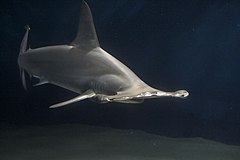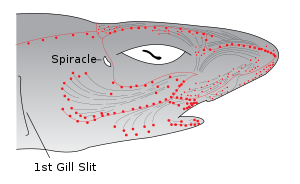Smell

The shape of the
hammerhead shark's head may enhance olfaction by spacing the nostrils further apart.
Sharks have keen
olfactory senses, located in the short duct (which is not fused, unlike bony fish) between the anterior and posterior nasal openings, with some species able to detect as little as one
part per million of blood in seawater.
They are more attracted to the chemicals found in the guts of many species, and as a result often linger near or in
sewage outfalls. Some species, such as
nurse sharks, have external
barbels that greatly increase their ability to sense prey.
Sight
Shark
eyes are similar to the eyes of other
vertebrates, including similar
lenses,
corneas and
retinas, though their eyesight is well adapted to the
marine environment with the help of a tissue called
tapetum lucidum. This means that sharks can contract and dilate their
pupils, like humans, something no
teleost fish can do. This tissue is behind the
retina and reflects light back to it, thereby increasing visibility in the dark waters. The effectiveness of the tissue varies, with some sharks having stronger
nocturnal adaptations. Sharks have eyelids, but they do not blink because the surrounding water cleans their eyes. To protect their eyes some species have
nictitating membranes. This membrane covers the eyes while hunting and when the shark is being attacked. However, some species, including the
great white shark (
Carcharodon carcharias), do not have this membrane, but instead roll their eyes backwards to protect them when striking prey. The importance of sight in shark hunting behavior is debated. Some believe that
electro- and
chemoreception are more significant, while others point to the nictating membrane as evidence that sight is important. Presumably, the shark would not protect its eyes were they unimportant. The use of sight probably varies with species and water conditions. The shark's field of vision can swap between
monocular and
stereoscopic at any time.
A
micro-spectrophotometry study of 17 species of Shark found 10 had only
rod photoreceptors and no cone cells in their
retinas giving them good night vision while making them
colorblind. The remaining seven species had in addition to rods a single type of
cone photoreceptor sensitive to green and, seeing only in shades of grey and green, are believed to be effectively colorblind. The study indicates that an objects contrast against the background, rather than colour, may be more important for object detection.
Hearing
Although it is hard to test sharks' hearing, they may have a sharp
sense of hearing and can possibly hear prey many miles away.
A small opening on each side of their heads (not the
spiracle) leads directly into the
inner ear through a thin channel. The
lateral line shows a similar arrangement, and is open to the environment via a series of openings called lateral line
pores. This is a reminder of the common origin of these two vibration- and sound-detecting organs that are grouped together as the acoustico-lateralis system. In bony fish and
tetrapods the external opening into the inner ear has been lost.
Electroreception

Electromagnetic field receptors (Ampullae of Lorenzini) and motion detecting canals in the head of a shark
The
Ampullae of Lorenzini are the
electroreceptor organs. They number in the hundreds to thousands. Sharks use the
Ampullae of Lorenzini to detect the
electromagnetic fields that all living things produce.
This helps sharks (particularly the
hammerhead shark) find prey. The shark has the greatest electrical sensitivity of any animal. Sharks find prey hidden in sand by detecting the
electric fields they produce.
Ocean currents moving in the
magnetic field of the
Earth also generate electric fields that sharks can use for orientation and possibly navigation.
Lateral line
This system is found in most fish, including sharks. It detects motion or vibrations in water. The shark can sense frequencies in the range of 25 to 50
Hz.


0 comments:
Post a Comment